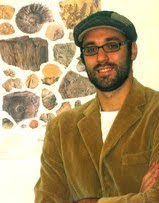In his website,
the influent artist Richard Long says: “my intention was to make a new art
which was also a new way of walking: walking as art […] These walks are
recorded or described in my work in three ways: in maps, photographs or text
works, using whichever form is the most appropriate for each different idea.
All these forms feed the imagination, they are the distillation of experience”.
The words of
Richard Long provide a link to geologists, ‘distillers of experience’ through the
act of walking. Indeed walking is the mean by which geologists record and
interpret the landscape, while distillations come in a wide variety of forms. Among
the commonest distilled experiences, geological field notes often provide
appealing visual material. In some cases, the
distinction between science or art is not obvious, such for the layers sketched
by Leonardo da Vinci and Giovanni Arduino.
 |
| The Arno valley sketched by Leonardo da Vinci. Note the accuracy in drawing sedimentary layers. |
 |
| Geological section realized by Giovanni Arduino in 1758. |
Nevertheless,
geological maps are probably the most emblematic forms through which geologists
distil their field experience. Geological maps show the spatial distribution of
geological units with different colours, therefore they are usually rich in
structure and patterns. It is not a case that they are often part of vibrant
works of art.
For instance, Nien
Schwarz used geologic maps in various artistic contexts. She used 55 grocery
bags made from geologic maps (‘From Legend to the Market’), tectonic maps
(‘Groundwork: an illustrated poem’), and hand-coloured geologic maps (‘Transpose’).
With the words of the artist (Baucon, 2009): “Transpose is a recent painting with map collage. It is constituted
by hand coloured geologic maps
1:67000 of the Northern Territory in Australia dating from
the 1960s. The
paint is made
with pure earth colours (no mixing of colours) – pigments
and rocks I have collected over the
years. I grinded
and sieved the rocks
and matched the
colours in the geologic map. This painting
is 2040 high
by 1240 wide and
70 mm deep.
It is made
on 2 house doors
covered in canvas
– doors as the
the literal and
symbolic threshold between inside
and outside – the divider between
nature and culture,
and desire and need.”
 |
| Nien Schwarz used 55 grocery bags made from geological maps for realizing her 'From Legend to Market'. Picture from nienschwarz.com |
Another
excellent example is the art of Chris Drury, who created various artworks by
weaving geological maps and topographical ones.
 |
| Particular of 'On the Ground, above and below Wyoming' by Chris Drury. Picture from the artist's website. |
 |
| Detail of the 'Geologist Series' by Perdita Phillips. Image from the artist's website. |
The mentioned examples
show clearly how artworks and geological maps are both distillation of
experience in the field. At this regard, Perdita Phillips artistically described the act of geological mapping in her ‘Geologist Series’. She
accompanied a field geologist in the Kimberly region (Australia) and
recorded the everyday tools and
practices of art and science. The artist was
interested “in the similarities and
differences between artists who
walked in the
field (i.e. walking as
an art medium)
and scientists who performed fieldwork” (Baucon, 2009).
Intriguingly,
this concept reconciles with the words (and the art) of Richard Long. According
to the principle of the ‘distillation of experience’, art and geology are languages
for describing the world. When I
interviewed Perdita Phillips on the subject, she gave an illuminating answer: “Imagine
two outstretched hands flat out in front of you that rub up against each other.
This is how I see art and science in
the field: their
practices are parallel and
sympathetic and ultimately
both aim to explain the world around them – the difference is in how the
observer is situated in the self-same world”.
 |
| Du Noyer is among the authors of this geological map. Detail from IHM. |
This
interpretation is supported by the work of a 19th century geological
celebrity: Georges Victor Du Noyer. Field geologist and artist, Du Noyer
surveyed vast areas of Ireland
and produced accurate geological maps. At the same time, he described his study
areas through delicate watercolours, illustrating the beauty of many geological
structures. It is manifest that Du Noyer’s geological maps and artworks are the
distillation of the same experiences: geology and art are connected by a
vibrant line of continuity.
 |
| Watercolor by Georges Victor Du Noyer depicting folds in the Old Red Sandstone. The outcrop is located near Mallow, in the same area of the geologic map above. Image from the GSI website. |
REFERENCES
Baucon A., 2009. Geology in Art. An Unorthodox Path from Visual Arts to Music. tracemaker.com, 120 pages
Baucon A., 2009. Geology in Art. An Unorthodox Path from Visual Arts to Music. tracemaker.com, 120 pages






Does not match with this (interesting) post but certainly with the overall scope of this blog. I found this site:
ReplyDeletehttp://soilscapestudio.com/
where a soil scientist Jay Stratton Noller mix soil science with his artistic vein.